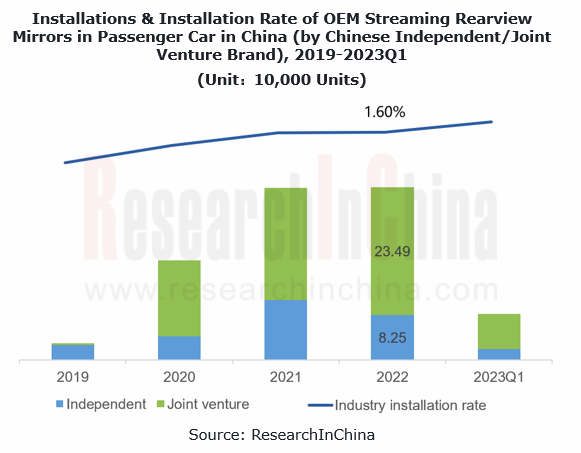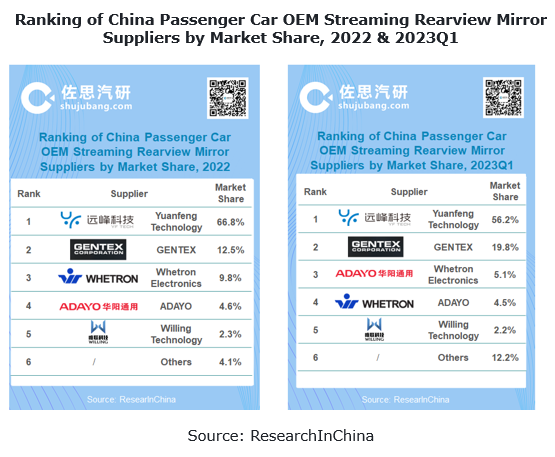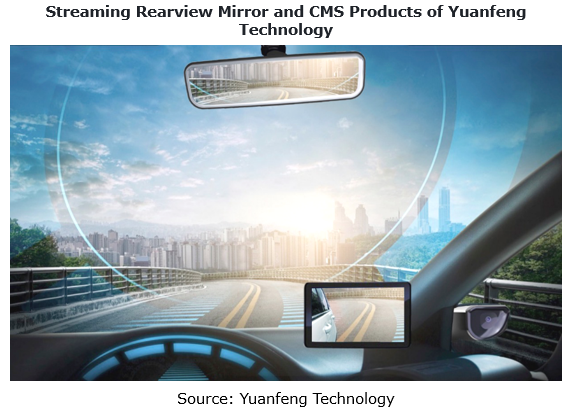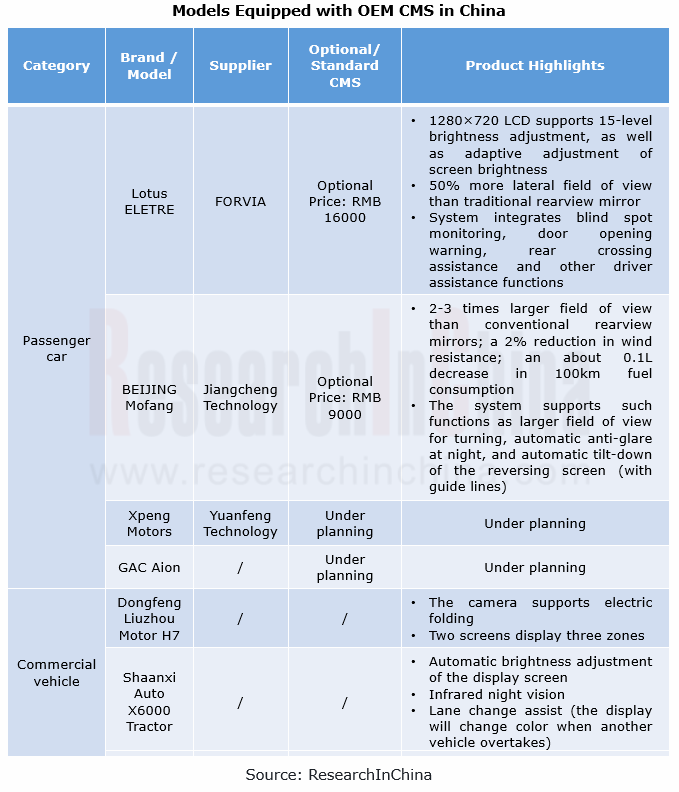Electronic rearview mirror research: 2023 will be the first year of mass production as the policy takes effect
Global and China Electronic Rearview Mirror Industry Report, 2023 released by ResearchInChina combs through and summarizes the installation, function application, development trends and products of global and Chinese suppliers.
By installation location, electronic rearview mirrors can be divided into electronic interior rearview mirror (i.e. streaming rearview mirror) and electronic exterior rearview mirror (i.e., camera monitor system, CMS). The "Motor Vehicles - Device for Indirect Vision - Requirement of Performance and Installation" (GB 15084-2022) will come into force on July 1, 2023. The policy stipulates that electronic rearview mirrors can be installed in Category M and N motor vehicles to replace conventional optical exterior rearview mirrors. The industry has grown out of nothing. This article will provide a respective overview of the streaming rearview mirror and CMS markets.
Streaming rearview mirror: the installations surge and the market competition intensifies.
In 2022, the installations of OEM streaming rearview mirrors in passenger cars in China approached 320,000 units, and the installation rate was 1.60%; the number of brands installing OEM streaming mirrors rose to 20, compared with 13 in the first five months of 2022.

In supplier’s term, Yuanfeng Technology still maintains its position as the bellwether in the industry, but the CR5 declined in 2023Q1, indicating a fiercer market competition.

Yuanfeng Technology's fourth-generation streaming rearview mirror products remain very superior in imaging time (25ms, <55ms required by regulations), image delay (<50ms, <200ms required by regulations), system minimum frame rate (≥50fps, ≥30Hz required by regulations) & display brightness (5500cd/m2), high dynamic range (up to 140dB), and self-adaption to high and low light environments. Its products have been installed by Cadillac, Buick, Chevrolet, Hongqi, WEY, Tank, Haval, GAC Trumpchi, GAC Honda, and GAC Toyota among others. Yuanfeng Technology stays far head of its counterparts in installations, having been the sales champion in China for years in a row.

Camera monitor system (CMS): available to quite a few models within the year, with the implementation of the policy.
On December 29, 2022, the Ministry of Industry and Information Technology (MIIT) released the "Motor Vehicles - Device for Indirect Vision - Requirement of Performance and Installation" (GB 15084-2022) and specified that it will go into effect on July 1, 2023. This means that CMS-enabled models will be legal to be mass-produced and travel on roads in China from July 1, 2023. Some models have been confirmed to pack CMS within the year.

Currently, Lotus Eletre and BAIC Mofang are confirmed to be equipped with CMS within 2023, both of which offer an optional package for consumers. In the case of FORVIA’s solution for Lotus Eletre, the CMS adopts 1280×720 LCD with a refresh rate of 60Hz, and supports 15-level brightness adjustment; the camera using water-proof materials can be heated to melt snow, and works with the active safety systems to provide functions like blind spot detection, door open warning, and rear cross traffic assist.

CMS well outperforms conventional rearview mirrors in the following aspects:
 All-day working capability, much stronger than conventional mirrors in special scenarios such as high light/dark environment, rain and snow
All-day working capability, much stronger than conventional mirrors in special scenarios such as high light/dark environment, rain and snow
 Adjustable FOV, effectively reducing blind spots
Adjustable FOV, effectively reducing blind spots
 Wind resistance reduction, and improvements in the BEV range / fuel consumption
Wind resistance reduction, and improvements in the BEV range / fuel consumption
 Video forensics in collision accidents
Video forensics in collision accidents
 Combined with driving assistance systems. CMS and ADAS have a high degree of overlap in functions such as blind spot detection. Currently, CMS products from Yuanfeng Technology and Autocruis can integrate steering assist, lane departure warning, side blind spot obstacle avoidance and other driving assistance functions.
Combined with driving assistance systems. CMS and ADAS have a high degree of overlap in functions such as blind spot detection. Currently, CMS products from Yuanfeng Technology and Autocruis can integrate steering assist, lane departure warning, side blind spot obstacle avoidance and other driving assistance functions.
There is a high possibility that CMS can share camera modules and controller components with other auto parts, producing good cost reduction effects. (According to the regulation in the GB15084-2022, that "in the case where CMS is used to provide a field of view, the relevant field of view shall be permanently visible to the driver when the ignition switch is turned on or the vehicle master control switch is activated", the display multiplexing is an infeasible way to lower the cost).
In terms of camera modules, currently a number of models (e.g., Xpeng G9 and Li L9) with L2+ driving assistance systems pack side cameras. If the CMS can share the camera with ADAS, a portion of the cost can be saved.
In terms of controllers, it is more likely that the CMS controller is integrated into the cockpit domain/driving domain. This solution is more in line with the centralization trend of E/E architectures. According to BAIC, the process will take 2 or 3 years.
Although CMS offers big benefits mentioned above, there are still some bottlenecks to be broken before mass adoption in vehicles, including:
 High cost poses a higher threshold to buy a car before the components are multiplexed. From the existing models with optional CMS on market, it can be seen that the cost of the optional system for customers ranges between RMB7,000 and RMB16,000. Except the purchase cost, the maintenance cost in later stage also increases.
High cost poses a higher threshold to buy a car before the components are multiplexed. From the existing models with optional CMS on market, it can be seen that the cost of the optional system for customers ranges between RMB7,000 and RMB16,000. Except the purchase cost, the maintenance cost in later stage also increases.
 System reliability in long-term use is guaranteed. CMS plays a crucial role in driving. Compared to conventional mirrors, CMS may crash and have a blank screen, causing a threat to safety driving
System reliability in long-term use is guaranteed. CMS plays a crucial role in driving. Compared to conventional mirrors, CMS may crash and have a blank screen, causing a threat to safety driving
 Driver's use habits change. In conventional rearview mirrors, the human eyesight is always in the distance, and what the driver sees is always a distant view; in CMS, the driver needs to take eyes back to the near place instead and refocus when observing the screen. The frequent switching of visual focus for a long time makes it easy to cause visual fatigue and affect driving safety.
Driver's use habits change. In conventional rearview mirrors, the human eyesight is always in the distance, and what the driver sees is always a distant view; in CMS, the driver needs to take eyes back to the near place instead and refocus when observing the screen. The frequent switching of visual focus for a long time makes it easy to cause visual fatigue and affect driving safety.
Autonomous Driving Domain Controller and Central Computing Unit (CCU) Industry Report, 2025
Research on Autonomous Driving Domain Controllers: Monthly Penetration Rate Exceeded 30% for the First Time, and 700T+ Ultrahigh-compute Domain Controller Products Are Rapidly Installed in Vehicles
L...
China Automotive Lighting and Ambient Lighting System Research Report, 2025
Automotive Lighting System Research: In 2025H1, Autonomous Driving System (ADS) Marker Lamps Saw an 11-Fold Year-on-Year Growth and the Installation Rate of Automotive LED Lighting Approached 90...
Ecological Domain and Automotive Hardware Expansion Research Report, 2025
ResearchInChina has released the Ecological Domain and Automotive Hardware Expansion Research Report, 2025, which delves into the application of various automotive extended hardware, supplier ecologic...
Automotive Seating Innovation Technology Trend Research Report, 2025
Automotive Seating Research: With Popularization of Comfort Functions, How to Properly "Stack Functions" for Seating?
This report studies the status quo of seating technologies and functions in aspe...
Research Report on Chinese Suppliers’ Overseas Layout of Intelligent Driving, 2025
Research on Overseas Layout of Intelligent Driving: There Are Multiple Challenges in Overseas Layout, and Light-Asset Cooperation with Foreign Suppliers Emerges as the Optimal Solution at Present
20...
High-Voltage Power Supply in New Energy Vehicle (BMS, BDU, Relay, Integrated Battery Box) Research Report, 2025
The high-voltage power supply system is a core component of new energy vehicles. The battery pack serves as the central energy source, with the capacity of power battery affecting the vehicle's range,...
Automotive Radio Frequency System-on-Chip (RF SoC) and Module Research Report, 2025
Automotive RF SoC Research: The Pace of Introducing "Nerve Endings" such as UWB, NTN Satellite Communication, NearLink, and WIFI into Intelligent Vehicles Quickens
RF SoC (Radio Frequency Syst...
Automotive Power Management ICs and Signal Chain Chips Industry Research Report, 2025
Analog chips are used to process continuous analog signals from the natural world, such as light, sound, electricity/magnetism, position/speed/acceleration, and temperature. They are mainly composed o...
Global and China Electronic Rearview Mirror Industry Report, 2025
Based on the installation location, electronic rearview mirrors can be divided into electronic interior rearview mirrors (i.e., streaming media rearview mirrors) and electronic exterior rearview mirro...
Intelligent Cockpit Tier 1 Supplier Research Report, 2025 (Chinese Companies)
Intelligent Cockpit Tier1 Suppliers Research: Emerging AI Cockpit Products Fuel Layout of Full-Scenario Cockpit Ecosystem
This report mainly analyzes the current layout, innovative products, and deve...
Next-generation Central and Zonal Communication Network Topology and Chip Industry Research Report, 2025
The automotive E/E architecture is evolving towards a "central computing + zonal control" architecture, where the central computing platform is responsible for high-computing-power tasks, and zonal co...
Vehicle-road-cloud Integration and C-V2X Industry Research Report, 2025
Vehicle-side C-V2X Application Scenarios: Transition from R16 to R17, Providing a Communication Base for High-level Autonomous Driving, with the C-V2X On-board Explosion Period Approaching
In 2024, t...
Intelligent Cockpit Patent Analysis Report, 2025
Patent Trend: Three Major Directions of Intelligent Cockpits in 2025
This report explores the development trends of cutting-edge intelligent cockpits from the perspective of patents. The research sco...
Smart Car Information Security (Cybersecurity and Data Security) Research Report, 2025
Research on Automotive Information Security: AI Fusion Intelligent Protection and Ecological Collaboration Ensure Cybersecurity and Data Security
At present, what are the security risks faced by inte...
New Energy Vehicle 800-1000V High-Voltage Architecture and Supply Chain Research Report, 2025
Research on 800-1000V Architecture: to be installed in over 7 million vehicles in 2030, marking the arrival of the era of full-domain high voltage and megawatt supercharging.
In 2025, the 800-1000V h...
Foreign Tier 1 ADAS Suppliers Industry Research Report 2025
Research on Overseas Tier 1 ADAS Suppliers: Three Paths for Foreign Enterprises to Transfer to NOA
Foreign Tier 1 ADAS suppliers are obviously lagging behind in the field of NOA.
In 2024, Aptiv (2.6...
VLA Large Model Applications in Automotive and Robotics Research Report, 2025
ResearchInChina releases "VLA Large Model Applications in Automotive and Robotics Research Report, 2025": The report summarizes and analyzes the technical origin, development stages, application cases...
OEMs’ Next-generation In-vehicle Infotainment (IVI) System Trends Report, 2025
ResearchInChina releases the "OEMs’ Next-generation In-vehicle Infotainment (IVI) System Trends Report, 2025", which sorts out iterative development context of mainstream automakers in terms of infota...